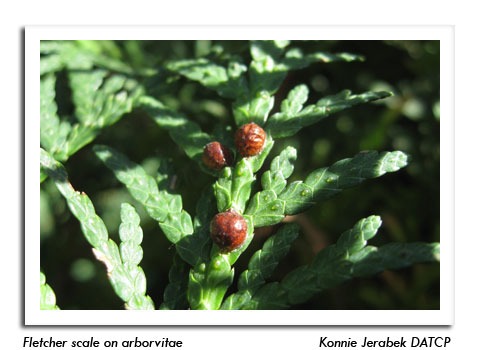
 |
|
|
Nursery & Forest
Volume 57 Number 8 Date 05/30/2012 ELM LEAFMINER - Larvae and leaf damage were noted on elm 'Pioneer' in an Ozaukee County nursery. The larval stages of this insect feed in between the epidermal layers of elm leaves, causing severe browning and eventual leaf drop. Damage is generally aesthetic and control is rarely needed, but repeated defoliation by leaf miners can impact the health of infected trees. BLACK SPOT - Symptoms of this fungal disease were observed on several rose cultivars at garden centers in Outagamie and Waukesha counties. Diagnostic characteristics are small, round black spots on the leaf surface which enlarge and cause leaves to turn yellow and prematurely fall. Development of this rose disorder is favored by humid, wet conditions and can be alleviated by increasing air circulation and removing infected leaves and debris. FLETCHER SCALE - Egg hatch and the emergence of mobile crawlers may begin in the next few days in southern Wisconsin. This scale pest of arborvitae, juniper and yew can cause premature needle drop or branch dieback. For severe infestations, horticultural oils or soaps, insect growth regulators, or conventional insecticides may be used as soon as the crawlers are noticed. --Liz Meils, DATCP Nursery Inspector GYPSY MOTH SPRAY - Bacillus thuringiensis var. kurstaki (Btk) treatments were applied to approximately 2,270 acres in Bayfield, Douglas and Sawyer counties on May 29-30, marking the completion of all Btk spraying in the state for the 2012 season. Mating disruption, or pheromone flake treatment, is scheduled to begin by mid-June in southwestern Wisconsin. The pheromone flakes are intended to interfere with population growth by disrupting gypsy moth mating. GYPSY MOTH SURVEY - Traps are now being placed at sites in 50 Wisconsin counties. As of May 30, about 3,195 traps, or 17% of the expected total, have been set. An estimated 19,000 traps will be deployed this year as part of the annual trapping program. --Nkauj Vang, DATCP Gypsy Moth Program 



|
|
|